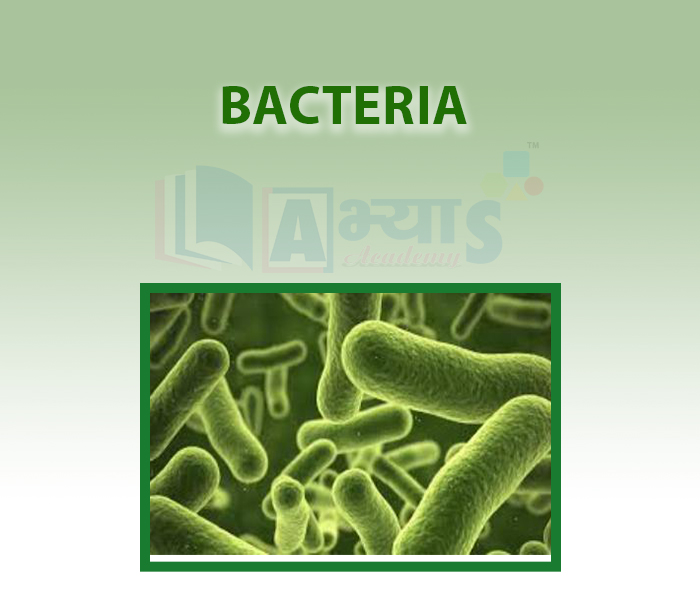Bacteria













Bacteria
In five kingdom classification bacteria is the sole member of kingdom Monera.
Characteristics of Bacteria :
For eg: Mycoplasma, Escherichia coli and blue - green algae or cynobacteria (Anabaena and Nostoc).
Cyanobacteria or blue green algae are the members of bacteria. They are called as the blue green algae because they also contain chlorophyll like plants and also perform photosynthesis. These bacteria perform the function of nitrogen fixation.
Bacteria can be beneficial or harmful for different living organisms.
Beneficial bacteria includes bacteria present in the our stomach which helps in digestion of food. Eg : Escherichia coli, Curd making bacteria, lactobacillus .
Harmful bacteria: Bacteria causes diseases like food poising (Clostridium botulinum), pneumonia (streptococcus bacterium) ,typhoid (Salmonella bacterium), tooth decay etc.
Rod-shaped bacteria are called bacilli (singular: bacillus), e.g., Bacillus anthracis, which causes the disease anthrax.
Spherical bacteria are called cocci (singular: coccus), e.g., Streptococcus pneumoniae, which causes the disease pneumonia.
Other types are spiral bacteria called spirilla and comma-shaped called vibrio.
Bacteria can be also be classified on the basis of Gram staining. If the bacteria take the gram stain or we can say get stained deeply then it is called as the gram positive bacteria and on the other hand if the bacteria does not take the stain then it is called as gram negative bacteria. This staining method was given by Christian Gram.
To kill the disease causing bacteria we use the antibiotics. Antibiotics are the medicine used by to kill the disease causing bacteria. The first antibiotic discovered by the Alexander Fleming was Penicillin.

The extra nuclear DNA in a bacteria cell contains genes for ___________________ . | |||
| Right Option : D | |||
| View Explanation | |||
Non - symbiotic nitrogen fixers are - | |||
| Right Option : A | |||
| View Explanation | |||
Conjugation is essential in Paramecium because - | |||
| Right Option : A | |||
| View Explanation |
Students / Parents Reviews [10]
Abhyas Methodology is very good. It is based on according to student and each child manages accordingly to its properly. Methodology has improved the abilities of students to shine them in future.

Manish Kumar
10thAbout Abhyas metholodology the teachers are very nice and hardworking toward students.The Centre Head Mrs Anu Sethi is also a brilliant teacher.Abhyas has taught me how to overcome problems and has always taken my doubts and suppoeted me.

Shreya Shrivastava
8thMy experience with Abhyas is very good. I have learnt many things here like vedic maths and reasoning also. Teachers here first take our doubts and then there are assignments to verify our weak points.

Shivam Rana
7thIt was a good experience with Abhyas Academy. I even faced problems in starting but slowly and steadily overcomed. Especially reasoning classes helped me a lot.

Cheshta
10thIt has a great methodology. Students here can get analysis to their test quickly.We can learn easily through PPTs and the testing methods are good. We know that where we have to practice

Barkha Arora
10thAbhyas is a complete education Institute. Here extreme care is taken by teacher with the help of regular exam. Extra classes also conducted by the institute, if the student is weak.

Om Umang
10thA marvelous experience with Abhyas. I am glad to share that my ward has achieved more than enough at the Ambala ABHYAS centre. Years have passed on and more and more he has gained. May the centre flourish and develop day by day by the grace of God.

Archit Segal
7thBeing a parent, I saw my daughter improvement in her studies by seeing a good result in all day to day compititive exam TMO, NSO, IEO etc and as well as studies. I have got a fruitful result from my daughter.

Prisha Gupta
8thMy experience with Abhyas academy is very good. I did not think that my every subject coming here will be so strong. The main thing is that the online tests had made me learn here more things.

Hiya Gupta
8thOne of the best institutes to develope a child interest in studies.Provides SST and English knowledge also unlike other institutes. Teachers are co operative and friendly online tests andPPT develope practical knowledge also.
